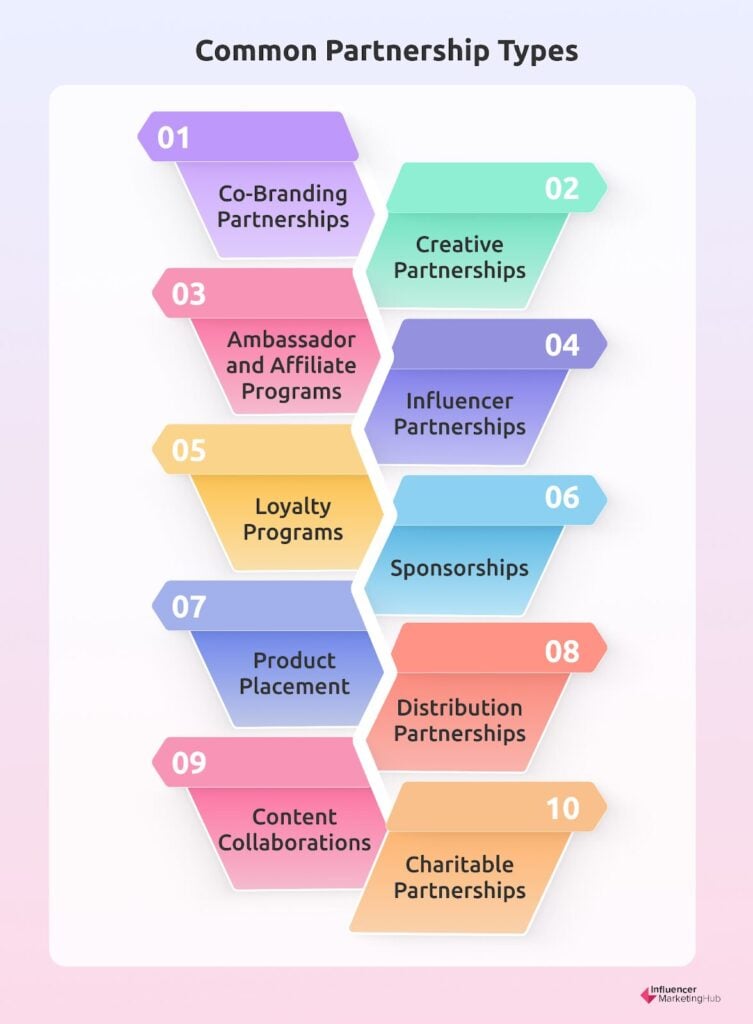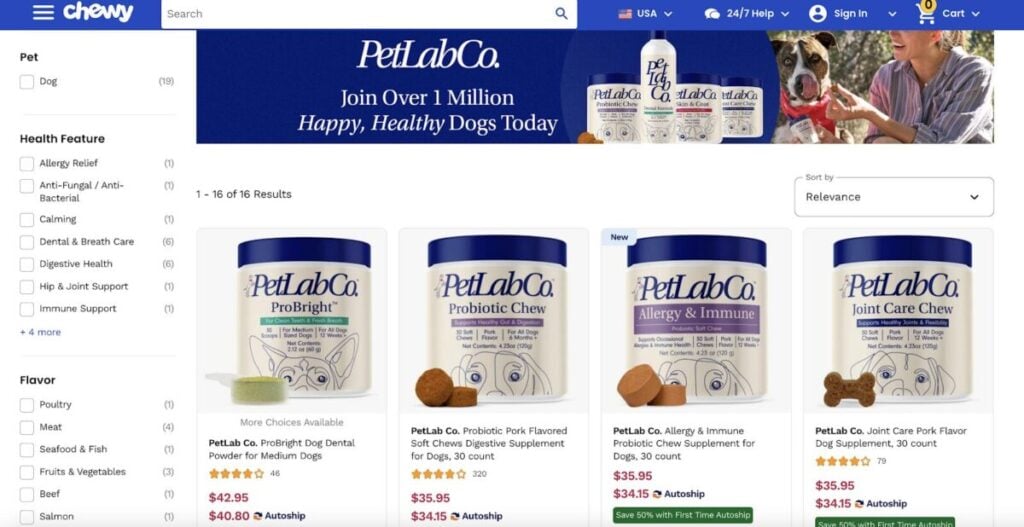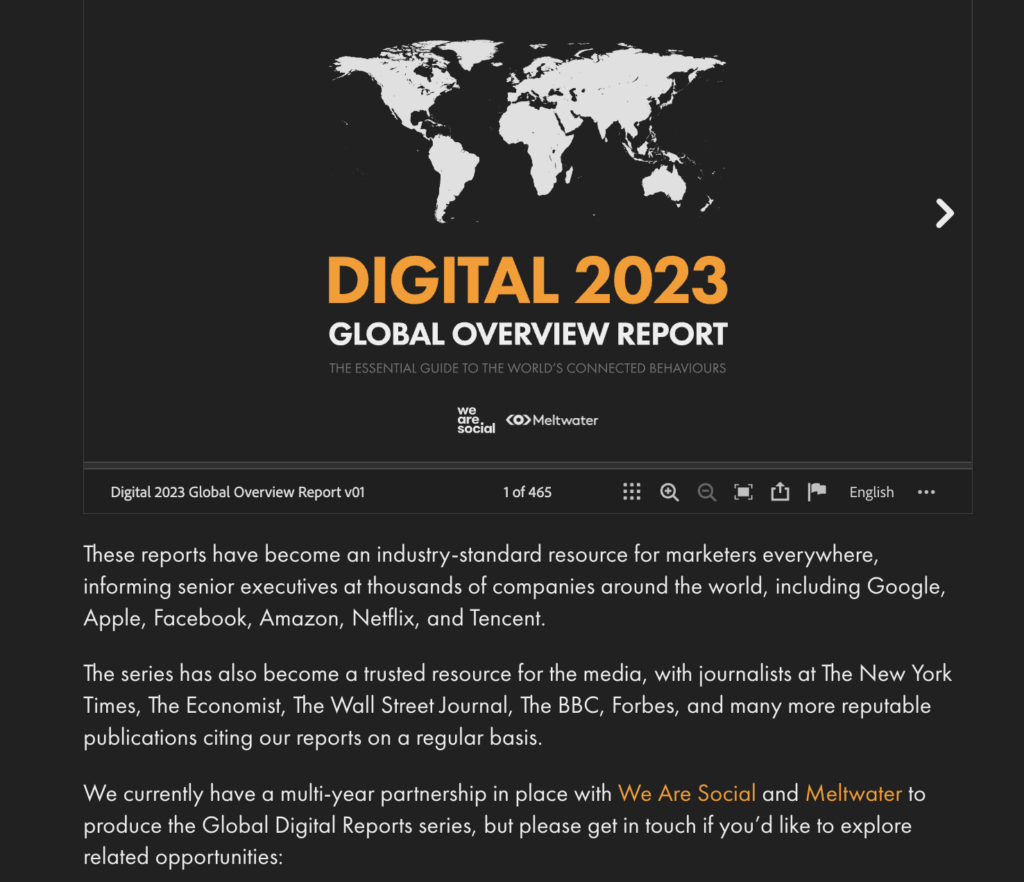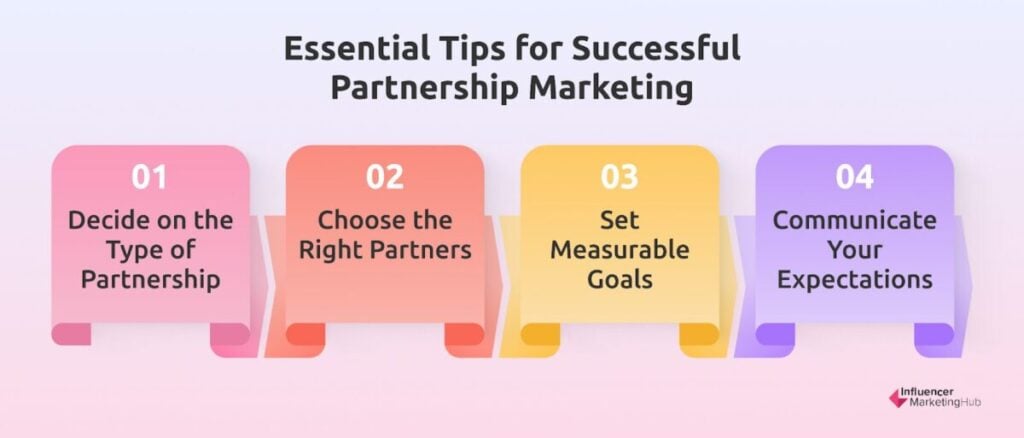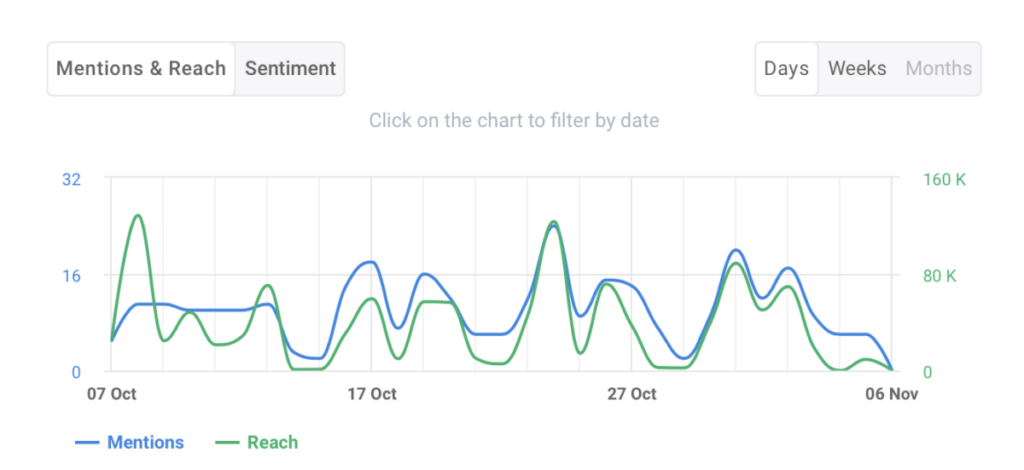What if we told you there was a way to stand out from the competition while simultaneously tapping into a new audience base? That’s exactly what you can accomplish with partner marketing. But what is partner marketing and how does it work? Most importantly, how can it add value to your business?
In this guide, we dive deep into the world of partner marketing and help you explore its many benefits. We even break down the common types of partnerships to inspire your own partner marketing strategy. Let’s take a look.
What is Partner Marketing?
Partner marketing, more commonly known as partnership marketing, is a mutually beneficial collaboration between two parties where each partner helps the other achieve their marketing goals. These goals may be related to growing an audience, attracting new customers, driving sales, or increasing overall brand awareness. In most cases, this type of partnership is formed between two businesses or between a business and a public figure.
ColourPop Cosmetics is a brand that consistently wins at partnership marketing by collaborating with popular franchises to create new makeup collections. For example, it recently partnered with Disney for a new collection promoting the latter’s “Haunted Mansion” movie. This allowed the brand to appeal to a community of horror fans while Disney tapped into ColourPop’s audience of makeup lovers.
Benefits of Partner Marketing
Even from what we’ve discussed so far, you can already get a fair idea of the benefits of partnering with another brand of public figure. To help you get an even better understanding of why you should consider it, let’s break down the benefits of partner marketing.
Tap into a New Audience
For starters, partnership marketing allows you to get your brand in front of your partner’s established audience. This means you can tap into a new audience and instantly expand your reach. So you gain increased visibility, which allows you to boost brand awareness.
Increase Your Value Proposition
Strategic partnerships allow you to offer something new to your audience to increase your value proposition. This may be in the form of new content, new products, and improved customer experiences to name a few.
Expand Revenue Channels (at a Lower Risk)
Partner marketing enables you to create additional revenue streams minus the risk. Since you’re working with a partner that has proven success, you can avoid the risks and pitfalls associated with the new venture.
Improve Brand Credibility
When you partner with a business or individual with an established trust with the audience, you can instantly improve your brand credibility. People are more likely to trust your brand when you work with a partner that has a solid reputation.
Save on Marketing Costs
Partnership marketing also has benefits in terms of cost savings. You’re essentially pooling your resources and expertise with your partner, which helps you save on overhead and get more out of your marketing dollars.
10 Different Types of Partnerships
So now that you have a better idea of how your business can benefit from partnering with another brand or public figure, you may be looking for ideas to get started. Here are some of the most common types of partnerships to inspire you.
1. Co-Branding Partnerships
This is when two reputable brands collaborate to create a new co-branded product or collection. In other words, the two brands put both their names on the product, allowing them to appeal to customers with an affinity for both brands. Think of the Nike x Stüssy partnership where the sportswear brand partnered with the fashion house originally known for surfwear.
2. Creative Partnerships
Sometimes, brands may also partner with an influential public figure to design a new product. This is a bit like co-branding but the main difference is that the public figure lends a creative hand in the design of the product. Following the Nike example above, the brand’s collaboration with Travis Scott who helped design a capsule collection of products for the Jordan brand can be considered a creative partnership.
Another example is Laika Studios partnering with artist Kimberly Perez who designed merch for the Coraline franchise. The two parties created an Instagram Collab post that showed up on both of their Feeds, thus helping promote the merch to both of their followers.
3. Ambassador and Affiliate Programs
A popular type of partner marketing involves working with brand ambassadors and affiliates. Also considered a form of influencer marketing, these ambassadors and affiliates are typically content creators and influencers who help promote your products in exchange for monetary compensation.
The terms “ambassador” and “affiliate” often get used interchangeably. One key difference is affiliates normally get paid a commission based on referrals whereas brand ambassadors get paid a fixed fee in exchange for the promotion. However, every program is different, so the specifics may vary depending on which brand created it. In both cases, the partnership is long-term, requiring partners to promote the brand on an ongoing basis.
YouTube creators like Mrwhosetheboss often share Amazon affiliate links for the products he features in his videos. He makes sure to mention that what he earns through those purchases will help him buy better gear.
4. Influencer Partnerships
Brands may also activate influencers for other types of partnerships such as giveaways, contests, reviews, gifting programs, and product placements to name a few. This allows the brand to tap into the influencer’s established follower base.
For example, Spoonflower partnered with artist and illustrator, Rhianna Wurman to host a “Doodle-A-Day January” challenge. During the partnership, the illustrator shared a doodle every day for the entire month of January based on a prompt provided by the brand.
Spoonflower also encouraged other people to participate while the artist helped to bring more awareness about the challenge. At the end of the partnership, the brand hosted a giveaway contest for users who share their final design to their Instagram grid.
5. Loyalty Programs
One of the most common types of partner marketing involves brands collaborating for a mutually beneficial loyalty and rewards program. Here, a business may give out points or other rewards in partnership with another business.
For instance, American Express gives customers the option to transfer their Membership Rewards points to the loyalty programs of their airline and hotel partners.
6. Sponsorships
Another common type of partner marketing is sponsorships. This typically involves a brand sponsoring an event such as a sports tournament or a fair to get more eyeballs. Brands may also sponsor athletes and sporting teams to get their name in front of a large audience.
With the popularity of esports and gaming today, it’s also common for brands to sponsor esports events and teams. Esports teams such as Team Liquid have a host of brand partners including Honda, Alienware, Coinbase, Twitch, SAP, and Monster.
7. Product Placement
Product placement is a subtle form of partner marketing where a brand pays a partner to showcase their products through visual media. This can often be found in influencer-generated content where a brand’s product is featured even if it’s not the main focus. On a larger scale, you’ll see this type of product placement in TV shows and movies.
Check out how the following influencer showcases her child’s room and tags several brands that are not explicitly mentioned in the caption. This is one example of product placement in action.
8. Distribution Partnerships
Another popular partner marketing tactic involves distribution partnerships where one brand leverages a partner’s distribution channels to promote its products. For example, a brand may work with a large retail store to sell their products. Or two brands may co-host a giveaway campaign where participants have the chance to win a hamper containing goodies from both brands.
For example, PetLab Co. sells their pet nutrition products through pet food retailer, Chewy. This allows them to reach a wider network of pet parents.
9. Content Collaborations
Brands may also collaborate with other businesses or content creators to co-create content. They may develop content assets together to tap into each other’s audience base. For example, one brand may host an interview that features experts from another brand.
Or they may work together to co-publish reports and studies relevant to their industry. Kepios has an ongoing partnership with We Are Social and Meltwater to publish an annual Global Digital Report series.
10. Charitable Partnerships
Brands often partner with nonprofits and charitable organizations to make a positive impact. This type of partnership marketing should be based on shared values and missions. For example, a company in the food and beverages industry could partner with an organization that helps feed the hungry.
Chewy regularly donates pet food and supplies to Greater Good Charities. The company donates up to $1 million worth of products to help rescue pets, which closely aligns with the brand’s values.
How to Succeed with Partner Marketing
Getting inspired by the partner marketing examples we highlighted above? Let’s help you get started with some tips on how to succeed with your own partnership marketing initiative.
1. Decide on the Type of Partnership
First, decide on the type of partnership that you want to create. Do you have the resources to develop new products with a partner? Or would you rather focus on promoting your existing products with influencer partners? Perhaps you’re looking for more ways to sell your products through distribution partners.
It’s important to have a clear idea of the type of partner marketing you want to engage in so you can strategically organize your efforts. Your decision will guide other aspects of your strategy such as the partners you work with and the objectives you target.
2. Choose the Right Partners
Based on the type of partnership you want, it’s time to look for the right partner. Whether your partnership involves another brand or a public figure, it’s important to look for someone who will be fully involved in the initiative. They should be able to consider it a team effort so that you’re not just carrying dead weight.
It’s not just enough to find a partner that fits the bill on paper. If possible, look for brands and individuals that your brand already has a “chemistry” with. For instance, you might have had friendly banter with them via social media. Or you might have interacted with their brand representatives at a networking event.
Having “chemistry” will help you establish a more authentic partnership. This is crucial for successful partner marketing that’s beneficial for both parties.
3. Set Measurable Goals
Like every type of marketing, partnership marketing should also be measured for effectiveness. Otherwise, how will you know that your investment is paying off? And how will you understand whether to pivot and optimize? This is why you need to set measurable goals to help you keep track of your performance.
Some common goals may be to raise brand awareness, drive more sales, garner brand affinity and loyalty, and improve brand reputation. Depending on which goal you select, you can identify the metrics and measurement tools that will help you measure the impact of your campaign.
For example, if your goal is brand awareness, you may want to use social media analytics tools to track reach and impressions as well as brand mentions and branded keywords. Tracking brand mentions and keywords will help you understand how many conversations are taking place about your brand and your partnership.
Alternatively, if your goal is to improve brand reputation, you’ll use social listening tools to track metrics like brand sentiment. Make sure to benchmark your performance against your pre-partnership metrics to see whether there’s a boost in brand perception.
4. Communicate Your Expectations
Finally, once your partnership is formed, it’s important to be transparent about your expectations. This will help you avoid disappointments and unexpected issues further down the line. Clearly communicate what you expect of your partner and make sure to understand their own expectations from you.
Every partnership should start with a discussion about the roles and responsibilities of each partner. Also, include details about the timeframes for meeting your goals and how to deal with roadblocks and challenges. Go beyond simply discussing these expectations and put them down in writing.
Gear Up for a Thriving Partnership
Making partner marketing work is all about forming the right types of partnerships with the right partners. Make the most of the tips and ideas we shared above to form a thriving partnership.
Frequently Asked Questions
What is B2B partner marketing?
B2B partner marketing is when B2B companies collaborate with other B2B companies to form mutually beneficial partnerships to boost brand awareness and increase sales.
What is brand partner marketing?
Brand partner marketing is when two brands work together to create mutually beneficial marketing strategies to promote their products and services.
What is the difference between partner marketing and affiliate marketing?
Partner marketing involves a collaboration between a brand and another brand or public figure to promote products and services. Affiliate marketing is a type of partner marketing that involves a publication or a content creator promoting a brand’s products and services through affiliate links in exchange for a commission.
What is a partner in affiliate marketing?
A partner in affiliate marketing is an individual or a company that helps promote the brand’s products and services through affiliate links. In exchange, they receive a commission for the sales and traffic they help generate.
What is channel partner marketing?
Channel partner marketing is a type of partner marketing where you work with dealers and distributors to promote and sell your products.

